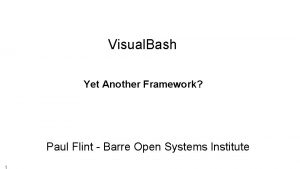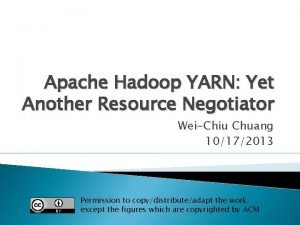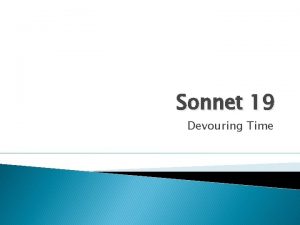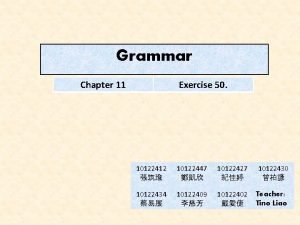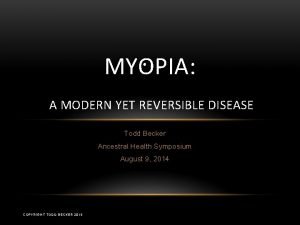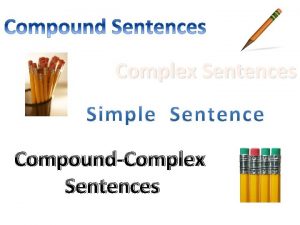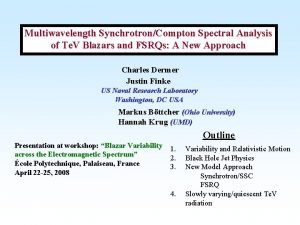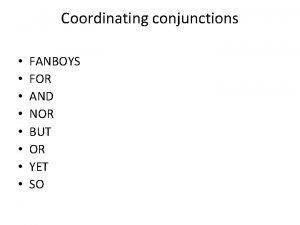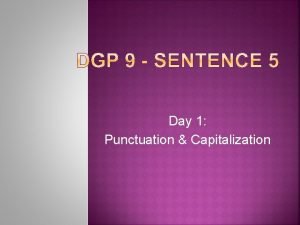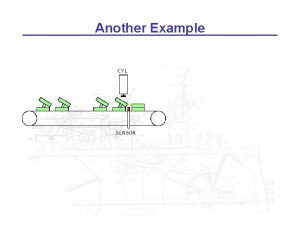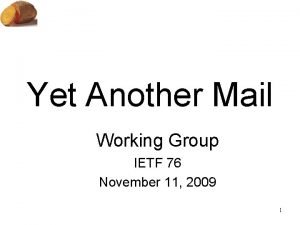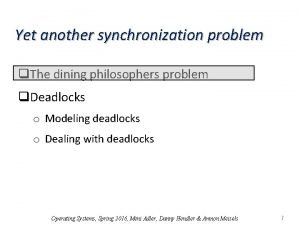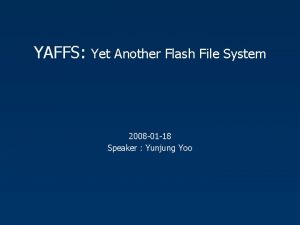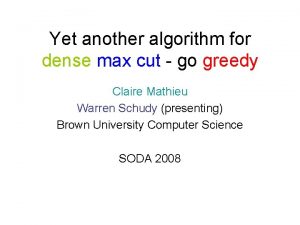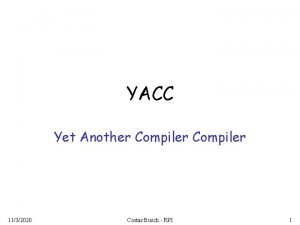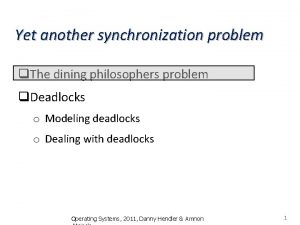ya Sp MV Yet Another Sp MV Framework















































- Slides: 47

ya. Sp. MV: Yet Another Sp. MV Framework on GPUs Shengen Yan, Chao Li, Yunquan Zhang, Huiyang Zhou 1

Introduction • Sparse Matrix-Vector Multiplication – spmv is a very important linear algebra algorithm – Serial implementation is quite simple // A*x=y, where A is stored in the CSR format. for (i = 0; i < m; ++i) { double y 0 = y[i]; for (k = rowptr[i]; k < rowptr[i+1]; ++k) y 0 = value[k] * x[column_index[k]]; y[i] = y 0; } – There are many work involved in its optimization on both CPUs and GPUs • Many formats have been proposed. 2

Introduction • Parallel implementation: two challenges – Bandwidth • the upper bound of flop: byte ratio is 0. 25 – Load imbalance • Different number of non-zeroes in different rows • Worse on GPUs 3 4 7 1 3 6 9 8 4 3

Executive Summary • BCCOO format – addressing the bandwidth challenge • Customized efficient segmented scan/sum – addressing load imbalance problem – very efficient • Results (GTX 680) – vs. CUSPARSE V 5. 0 • up to 229% and 65% on average improvement – vs. cl. Sp. MV • up to 195% and 70% on average improvement 4

Outline • Introduction • Formats for Sp. MV – addressing the bandwidth challenge • • Efficient Segmented Sum/Scan for Sp. MV Auto-Tuning Framework Experimentation Conclusions 5

COO format of matrix A 6

Blocked COO (BCOO) format 7

Blocked COO (BCOO) format 3 0 5 1 0 1 BCOO format block size 2 x 2 8

Blocked COO (BCOO) format 3 0 6 9 5 1 4 0 0 0 1 3 BCOO format block size 2 x 2 9

Blocked COO (BCOO) format 3 0 6 9 0 07 2 3 5 5 1 4 0 4 71 3 8 4 0 0 1 1 3 0 2 3 BCOO format block size 2 x 2 10

Blocked compressed COO (BCCOO) format Row Index Compression Ratio: 1/32 Bit Integer 3 0 6 9 0 07 2 3 5 5 1 4 0 4 71 3 8 4 0 0 1 1 1 0 0 1 1 0 1 3 0 2 3 BCCOO format block size 2 x 2 11

Formats for Sp. MV • Extensions of BCCOO format – BCCOO+ format • Rearrange the non-zeros blocks. • Relief the irregular access to the vector – Column index compression • Using difference function on the column index. 12

Example matrix • Assume there are 4 threads BCCOO format of matrix B (Block size 1 x 1) 13

Auxiliary Information for Sp. MV: Result Entry • Getting the location of the first result generated by each thread in the output array. That’s to say to compute the row index that the first result in each thread belongs to. • Only need to count the zero number in the bit flag array of the previous threads. 0 0 2 3 Thread 0 Thread 1 Thread 2 Thread 3 14

Outline • Introduction • Formats for Sp. MV • Efficient Segmented Sum/Scan for Sp. MV – addressing load imbalance problem • Auto-Tuning Framework • Experimentation • Conclusions 15

Even workload partition • No workload imbalance Non-zero Blocks workgroup 0 workgroup 1 workgroup 2 workgroup 3 threads T 0 T 1 T 2 T 3 16

Efficient Segmented Sum/Scan for Sp. MV • Three logic steps – Read the data and multiply them with the corresponding vector values. – Perform a segmented sum/scan using the bit flag array from our BCCOO/BCCOO+ format – Results combination and write back the results to global memory. • All these three steps are implemented in one kernel 17

Step 1 Read the data and multiply with vector values • Ex: 4 Threads BCCOO format of matrix B 18

Step 1 Read the data and multiply with vector values • Ex: 4 Threads Problem: B*x =? Assume: x=[2 9 6 5 4 8 7 3] 0 2 4 6 2 6 4 7 X = 19

Step 2 Segmented sum/scan • Three types of rows in our algorithm – All the non-zeros of the row are in the same thread. • Serial segmented sum/scan in threads – A row spans multiple threads. • + Parallel segmented sum/scan among threads. – A row spans multiple workgroups. • + Cross workgroup synchronization (details in paper)

Step 2 Segmented sum/scan • 1) Serial segmented sum/scan in each thread Problem: B*x =? Assume: x=[2 9 6 5 4 8 7 3] Serial Segmented Scan (intermediate[-1]=0): Intermediate[i] = intermediate[i-1] * Bit. Flag[i-1] + Intermediate[i] Scan 27 5 33 36 21

Step 2 Segmented sum/scan • 2) Generate last partial sum and perform parallel segmented scan among threads for the last partial sum Scan 78 0 Scan 36 1 Scan 99 1 0 1 Parallel segmented scan 78 36 99 0 22

Step 2 Segmented sum/scan • 2) Generate last partial sum and perform parallel segmented scan among threads for the last partial sum 1 Scan 78 0 Scan 36 1 Scan 99 0 1 Parallel segmented scan 78 36 135 99 0 23

Step 3 Results combination and write the results to global memory. Assume: x=[2 9 6 5 4 8 7 3] Problem: B*x =? 0 0 27 33 56 97 + 105 33 92 + + 105 33 92 196 0 0+1 2 3 196 24

Auto-Tuning Framework • In order to generate the optimal kernel code, we employ the auto-tuning technique to search the best parameters. Average auto-tuning time: 13 seconds Auto-tuning speed: ~1 million non-zeros per seconds Tunable parameters 25

Experiments • Experimental Methodology – We have implemented our proposed scheme in Open. CL. – We have evaluated our scheme on GTX 480 and GTX 680 using 20 real world matrices. – Comparison library • CUSPARSE V 5. 0 (Nvidia official Sp. MV library) • CUSP (SC 09) • cl. Sp. MV (ICS 12) 26

Name Size Non-zeros (NNZ) NNZ/Row Dense 2 K * 2 K 4 M 2000 Protein 36 K * 36 K 4. 3 M 119 FEM/Spheres 83 K * 83 K 6 M 72 FEM/Cantilever 62 K * 62 K 4 M 65 Wind Tunnel FEM/Harbor QCD FEM/Ship Economics Epidemiology FEM/Accelerator Circuit 218 K*218 K 47 K * 47 K 49 K * 49 K 141 K*141 K 207 K*207 K 526 K*526 K 121 K*121 K 171 K*171 K 11 M 2. 3 M 1. 9 M 7. 8 M 1. 2 M 2. 1 M 2. 6 M 0. 95 M 53 59 39 28 6 4 22 6 Webbase 1 M * 1 M 3 LP 4 K * 1. 1 M 11. 3 M 2825 Circuit 5 M 5. 56 M* 5. 56 M 59. 5 M 11 eu-2005 Ga 41 As 41 H 72 863 K*863 K 268 K*268 K 1. 38 M* 1. 38 M 19. 2 M 18. 4 M 22 67 17 M 12 mip 1 66 K * 66 K 10. 3 M 152 Si 41 Ge 41 H 72 186 K*186 K 15 M 81 in-2004 Used Matrices 27

FE n Pr se M o FE /S tein M ph /C er a e W ntil s in ev d e FE Tun r M n /H el ar bo r Q FE CD M Ec /Sh Ep ono ip FE ide mi M m cs /A io cc log el y er at o Ci r W rcui eb t ba se Ci rc LP ui t 5 Ga eu M 41 -20 As 05 41 H in 72 -2 00 4 Si 4 m 1 G ip e 4 1 1 H H- 72 m ea n De GFLOPS CUSPARSE 70 60 50 40 30 20 10 0 Performance results on Kepler (GTX 680) 28

FE n Pr se M o FE /S tein M ph /C er a e W ntil s in ev d e FE Tun r M n /H el ar bo r Q FE CD M Ec /Sh Ep ono ip FE ide mi M m cs /A io cc log el y er at o Ci r W rcui eb t ba se Ci rc LP ui t 5 Ga eu M 41 -20 As 05 41 H in 72 -2 00 4 Si 4 m 1 G ip e 4 1 1 H H- 72 m ea n De GFLOPS CUSPARSE CUSP 70 60 50 40 30 20 10 0 Performance results on Kepler (GTX 680) 29

FE n Pr se M o FE /S tein M ph /C er a e W ntil s in ev d e FE Tun r M n /H el ar bo r Q FE CD M Ec /Sh Ep ono ip FE ide mi M m cs /A io cc log el y er at o Ci r W rcui eb t ba se Ci rc LP ui t 5 Ga eu M 41 -20 As 05 41 H in 72 -2 00 4 Si 4 m 1 G ip e 4 1 1 H H- 72 m ea n De GFLOPS CUSPARSE CUSP cl. Sp. MV Cocktail 70 60 50 40 30 20 10 0 Performance results on Kepler (GTX 680) 30

FE n Pr se M o FE /S tein M ph /C er a e W ntil s in ev d e FE Tun r M n /H el ar bo r Q FE CD M Ec /Sh Ep ono ip FE ide mi M m cs /A io cc log el y er at o Ci r W rcui eb t ba se Ci rc LP ui t 5 Ga eu M 41 -20 As 05 41 H in 72 -2 00 4 Si 4 m 1 G ip e 4 1 1 H H- 72 m ea n De GFLOPS CUSPARSE CUSP cl. Sp. MV Cocktail cl. Sp. MV Best single 70 60 50 40 30 20 10 0 Performance results on Kepler (GTX 680) 31

CUSPARSE CUSP cl. Sp. MV Cocktail cl. Sp. MV Best single ya. Sp. MV 70 60 40 Average Performance Improvement: 65% over CUSPARSE, 70% over cl. Sp. MV COCKTAIL, 88% over cl. Sp. MV best single, 150% over CUSP 30 20 10 n Pr se M o FE /S tein M ph /C er a e W ntil s in ev d e FE Tun r M n /H el ar bo r Q FE CD M Ec /Sh Ep ono ip FE ide mi M m cs /A io cc log el y er at o Ci r W rcui eb t ba se Ci rc LP ui t 5 Ga eu M 41 -20 As 05 41 H in 72 -2 00 4 Si 4 m 1 G ip e 4 1 1 H H- 72 m ea n 0 FE De GFLOPS 50 Performance results on Kepler (GTX 680) 32

FE n Pr se M o FE /S tein M ph /C er a e W ntil s in ev d e FE Tun r M n /H el ar bo r Q FE CD M Ec /Sh Ep ono ip FE ide mi M m cs /A io cc log el y er at o Ci r W rcui eb t ba se Ci rc LP ui t 5 e Ga u M 41 -20 As 05 41 H 7 in 2 -2 00 4 Si 4 m 1 G ip e 4 1 1 H H- 72 m ea n De GFLOPS COO 70 60 50 40 30 20 10 0 Performance breakdown on Kepler (GTX 680) 33

FE n Pr se M o FE /S tein M ph /C er a e W ntil s in ev d e FE Tun r M n /H el ar bo r Q FE CD M Ec /Sh Ep ono ip FE ide mi M m cs /A io cc log el y er at o Ci r W rcui eb t ba se Ci rc LP ui t 5 e Ga u M 41 -20 As 05 41 H 7 in 2 -2 00 4 Si 4 m 1 G ip e 4 1 1 H H- 72 m ea n De GFLOPS COO BCCOO 70 60 50 40 30 20 10 0 Performance breakdown on Kepler (GTX 680) 34

FE n Pr se M o FE /S tein M ph /C er a e W ntil s in ev d e FE Tun r M n /H el ar bo r Q FE CD M Ec /Sh Ep ono ip FE ide mi M m cs /A io cc log el y er at o Ci r W rcui eb t ba se Ci rc LP ui t 5 e Ga u M 41 -20 As 05 41 H 7 in 2 -2 00 4 Si 4 m 1 G ip e 4 1 1 H H- 72 m ea n De GFLOPS COO BCCOO Efficient Segmented Sum/Scan 70 60 50 40 30 20 10 0 Performance breakdown on Kepler (GTX 680) 35

FE n Pr se M o FE /S tein M ph /C er a e W ntil s in ev d e FE Tun r M n /H el ar bo r Q FE CD M Ec /Sh Ep ono ip FE ide mi M m cs /A io cc log el y er at o Ci r W rcui eb t ba se Ci rc LP ui t 5 e Ga u M 41 -20 As 05 41 H 7 in 2 -2 00 4 Si 4 m 1 G ip e 4 1 1 H H- 72 m ea n De GFLOPS COO BCCOO Efficient Segmented Sum/Scan Adjacent Synchronization 70 60 50 40 30 20 10 0 Performance breakdown on Kepler (GTX 680) 36

COO BCCOO Efficient Segmented Sum/Scan Adjacent Synchronization Fine-Grain Optimizations 70 60 GFLOPS 50 40 30 20 10 Average Performance Improvement (vs. COO format): +BCCOO: 66% +Efficient Segmented Sum/Scan: 192% +Adjacent Synchronization: 212% +Fine-Grain Optimizations: 257% De ns FE Pro e M FE /S tein M ph /C er a e W ntil s in ev d e FE Tun r M n /H el ar bo r Q FE CD M Ec /Sh Ep ono ip FE ide mi M m cs /A io cc log el y er at o Ci r W rcui eb t ba se Ci rc LP ui t 5 e Ga u M 41 -20 As 05 41 H 7 in 2 -2 00 4 Si 4 m 1 G ip e 4 1 1 H H- 72 m ea n 0 Performance breakdown on Kepler (GTX 680) 37

De ns P FE r e M o FE /S tein M ph /C er a e W ntil s in ev d e FE Tun r M n /H el ar bo r Q FE C M D Ec /Sh Ep ono ip FE ide mi M m cs /A io cc log el y er at o Ci r W rcui eb t ba se Ci rc LP ui t 5 Ga eu M 41 -20 As 05 41 H in 72 -2 00 4 Si 4 m 1 G ip e 4 1 1 H Av 72 er ag e Relative memory footprint COO 0. 80 0. 70 0. 60 0. 50 0. 40 0. 30 0. 20 ELL Cocktail Best single BCCOO 1. 00 0. 90 Average memory footprint consumption: vs. COO: 60% vs. ELL: 19% vs. Cocktail: 79% vs. Best single: 69% 0. 10 0. 00 Relative memory footprint of different formats 38

Conclusions • The BCCOO format – Addressed the memory bandwidth problem • The customized matrix-based segmented sum/scan algorithms – Addressed the work load imbalance problem – Only need to invoke one kernel. – Very efficient: used a lot of optimization approaches. • Results (GTX 680) – Vs. CUSPARSE V 5. 0 • up to 229% and 65% on average improvement – Vs. cl. Sp. MV • up to 195% and 70% on average improvement • Code is available online – http: //code. google. com/p/yaspmv/ 39

Thanks & Question? 40

COO format 41

COO format 3 0 2 42

COO format 36 00 26 43

Step 2 Segmented sum/scan • 3) Accumulating partial sums across workgroups Generate Partial Sums P 0 Step 3 Generate Partial Sums P 1 Step 3 Generate Partial Sums P 2 P 3 Step 3 Using Adjacent Synchronization 44

Fine-grained optimizations • Texture memory for vector read • Cut the adjacent synchronization chain as early as possible • Remove the parallel segmented scan if possible • If the number of columns is smaller than 65535 short type column index array may be helpful to decrease the memory traffic. 45

CUSPARSE CUSP cl. Sp. MV Cocktail cl. Sp. MV Best singel ya. Sp. MV 70 60 40 30 20 10 Average Performance Improvement: 42% over CUSPARSE, 40% over cl. Sp. MV COCKTAIL, 60% over cl. Sp. MV best single, 74% over CUSP 0 De ns P r FE o e FE M/ te M/ Sp in Ca he nt re Wi il s nd ev er FE Tun M/ ne Ha l rb or FE QC M D Ec /Sh E on ip FE pid om M/ em ic Ac io s ce lo le gy ra Ci tor rc We uit bb as e Ci rc LP ui t 5 e u Ga - M 41 20 As 05 41 in H 72 -2 00 4 Si m 41 i Ge p 1 41 H H- 72 me an GFLOPS 50 Performance results on Fermi (GTX 480) 46

ns P FE ro e M FE /S tein M ph /C er a e W ntile s in d ver FE Tun M ne /H l ar bo r FE QCD M Ec /Sh Ep ono ip FE ide mic M m s /A iol cc og el y er at o Ci r r W cui eb t ba se Ci rc LP ui t 5 Ga eu M 41 -20 As 05 41 H 7 in 2 -2 00 4 Si 4 m 1 G ip e 4 1 1 H Av 72 er ag e De Millions COO BCCOO 800 700 600 500 400 300 200 100 0 Absolute memory footprint consumption of COO, BCCOO formats 47
 Yet another framework
Yet another framework Lex yacc example
Lex yacc example Yarn yet another resource negotiator
Yarn yet another resource negotiator Happy hump day images
Happy hump day images The mysteries of harris burdick the harp
The mysteries of harris burdick the harp Drawing a conceptual framework
Drawing a conceptual framework Conceptual framework theoretical framework
Conceptual framework theoretical framework Dispositional framework vs regulatory framework
Dispositional framework vs regulatory framework Dispositional framework vs regulatory framework
Dispositional framework vs regulatory framework Conceptual vs theoretical framework
Conceptual vs theoretical framework Conceptual framework vs theoretical framework
Conceptual framework vs theoretical framework Present perfect continuous tense negative rule
Present perfect continuous tense negative rule Shakespeare devouring time
Shakespeare devouring time The president yelled we must have peace
The president yelled we must have peace Present perfect with just already and yet
Present perfect with just already and yet The winner of the race hasn't been announcing yet
The winner of the race hasn't been announcing yet Inatgr
Inatgr Is nearsightedness reversible
Is nearsightedness reversible Lamentations 3 22-23 amp
Lamentations 3 22-23 amp Are we cool yet
Are we cool yet Compound complex sentences
Compound complex sentences Linda has just walked outside with grandmother
Linda has just walked outside with grandmother Most yet black hole
Most yet black hole Still not there yet
Still not there yet Yet not to thine eternal resting place
Yet not to thine eternal resting place Romeo and juliet act 2 timeline
Romeo and juliet act 2 timeline Don't eat the marshmallow yet
Don't eat the marshmallow yet Opposing transition words
Opposing transition words Answer
Answer Compound sentence 30
Compound sentence 30 Sonnet 29 quatrain analysis
Sonnet 29 quatrain analysis 10 things i hate about you poem
10 things i hate about you poem I’m sorry that i didn’t finish my homework last night
I’m sorry that i didn’t finish my homework last night Yet here's a spot
Yet here's a spot Free yet morally obliging
Free yet morally obliging Use yet in a sentence
Use yet in a sentence Characteristic features of culture
Characteristic features of culture If not yet done
If not yet done You are arent you
You are arent you Fanboys connectors
Fanboys connectors Literary devices macbeth act 1
Literary devices macbeth act 1 The 3 apparitions in scene 1 leave macbeth feeling
The 3 apparitions in scene 1 leave macbeth feeling Jeb likes cars but he cant drive yet
Jeb likes cars but he cant drive yet Hold thy desperate hand art thou a man
Hold thy desperate hand art thou a man Yet herein will i imitate the sun
Yet herein will i imitate the sun Chresteuomai
Chresteuomai Staxi-2 c/a
Staxi-2 c/a They haven't finished their homework
They haven't finished their homework
